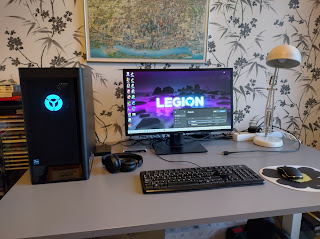Building blocks of good game
What is important when designing game? Is it the look, gameplay, or systematic way of working and good documentation? I've been thinking these aspecs, while drafting the design document for my first game.
I started diving into the world of video games in mid 1980's, when visual look of games was quite primitive compared to modern games. The limiting factors were the memory and performance, and video game developers had to push the hardware to the limits while implementing unprecedented games. Game development was also less professional at that time, and a motivated hobbyist was able to create a AAA-class commercial game in the corner of his living room (or at least I have been told so :) ). Despite of limited resources, very entertaining and addictive games were produced at those days. For example, C64 had total of 64kbytes of memory and 8-bit CPU running @1MHz and still it was able to run Elite, M.U.L.E, Ultima series, Boulder Dash, International Karate and many many more classic games.
How in the earth it was possible to create so fascinating worlds with so limited resources? At those times it seemed like magic for me, but later I understood that it was the game developers' expertise, technical knowledge, and understanding what makes the game entertaining. As an engineer I appreciate ingenious technical solutions that are utilizing available resources as effectively as possible.
Bit later, in the end of 1980's started the era of 16-bit computers with more memory, better graphics and sound, and more powerful CPUs. Game developers had the change to create larger and visually striking games, without stretching the hardware to the limit. Great and entertaining games were published, but in some cases the focus was clearly in visual appearance at the expense of gameplay. There were also less visual games with more content, like ASCII-graphics based Moria (or Angband), that was distributed as public domain. Anyways, from my point of view the best games of that time had the perfect mix of gameplay and visual appearance. Good examples of them are Lemmings, Dungeon Master, Populous, F-19 Stealth Fighter, Ultima V, etc. You name it. :)
Modern computers and consoles have hundreds (or thousands) times the computing power of the early computers, but still developers tend to stretch the performance limits with their latest AAA-class titles. Game projects can be very large and complex, and may have a budget of tens of millions euros. Development teams have very wide range of skills, and I would guess managing such a team is a real challenge! The risks are high, so projects are under strict supervision (or at least should be!) in order to minimize financial losses. At the latest this is the point to introduce the conscientious documenting and systematic way of working.
Mobile devices are evolving wildly, and their performance and complexity is getting closer and closer to traditional computers. Advanced development tools and distribution methods make it easier to create casual games for them, and it can be seen in the huge numbers of applications for the most common platforms. However, very few games can make a profit or even break even, and the challenge is how to stand out from competitors. It is interesting to see how the mobile games market is formed over the time. I don't have clear understanding how mobile games are currently developed, but I think the development work is moving closer and closer to the console or computer game development work when the device performance and complexity increases.
After all, I believe a good (commercial) game has all the elements mentioned in the beginning: It is developed in a systematic way and it has great gameplay (most important!) and visual outlook. Hobby projects are different matter, but bigger projects are easier to manage when the work is documented well.



Comments
Post a Comment